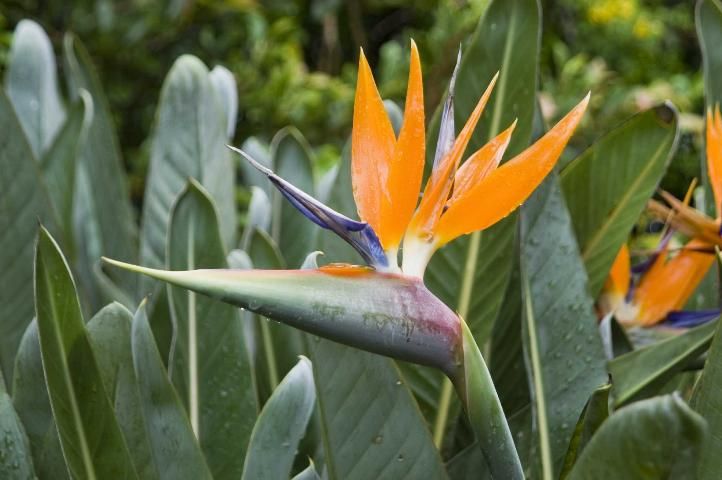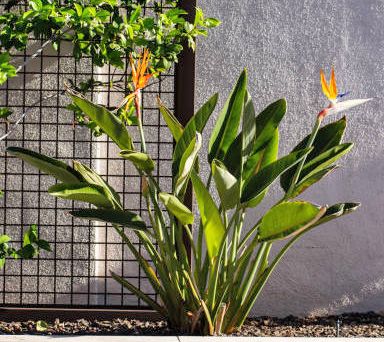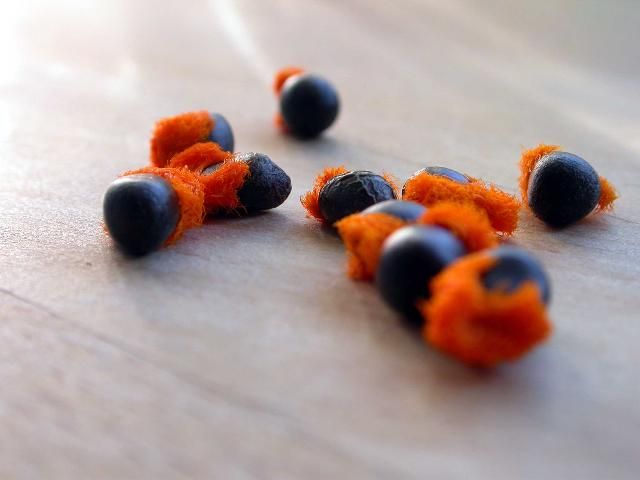Description
Bird-of-paradise or crane flower (Strelitzia reginae) is a native of South Africa and is closely related to the banana. The herbaceous plant derives its common names from the unique flower it bears, which resembles a brightly colored bird in flight (Figure 1). The leathery leaves are held upright on stiff leafstalks and are about 6 inches wide and 18 inches long. The plant forms a 3- to 5-foot-tall clump that can be used as a focal point in the landscape (Figure 2) or in mass plantings. The evergreen leaves of bird-of-paradise do not drop from the plant, which makes it an excellent addition around pools or wherever shedding leaves are an aesthetic and/or maintenance problem.
Bird-of-paradise makes an attractive landscape plant throughout Florida although it requires cold protection in the northern part of the state. The plant will tolerate temperatures as low as 24°F for a short time; however, freezing temperatures will damage developing flower buds and flowers. To ensure flower production in north Florida, grow bird-of-paradise in a container that can be moved indoors during freezes.

Credit: Design Pics
The showy bloom is actually a combination of blue petals and orange sepals that emerge from a beak-like bract (modified leaf). Blooms appear intermittently most of the year. Healthy, mature plants can produce as many as three dozen flower spikes a year, which will last up to two weeks when cut.

Credit: UF/IFAS
Related Species
Bird-of-paradise is a member of the Strelitziaceae family which contains other species often seen in central and south Florida landscapes. S. nicolai (white or giant bird-of-paradise) grows to 15-30 feet and has large, paddle-like leaves arranged spirally around a distinct stem. Its large size and white flowers resemble the traveler's tree (Ravenala madagascariensis). However, the leaves of traveler's tree are arranged in a flattened, symmetrical fan and the flowers lack blue petals. New shoots of traveler's tree are produced at the base of the plant and should be removed if a solitary form is desired. White bird-of-paradise grows more slowly than traveler's tree and is more cold tolerant. It also produces dense offshoots that should be thinned occasionally.
Planting and Care
Culture Information
Bird-of-paradise grows in most soils, but does best in fertile, organic soils with good drainage. It is considered to be a slow-growing plant. For good flower production, place plants in sunny or partially shaded locations. Plants grown in partial shade will be taller and have somewhat larger flowers. In full sun, plants are smaller and flowers are on shorter stems. The bird-of-paradise will tolerate light salt spray but should not be used in exposed locations near the ocean.
Bird-of-paradise tends to produce more flowers along the outside of the plant. Thus, spacing the plants at least 6 feet apart will allow adequate space for flowering.
Planting Information
The planting hole should be dug 2 to 3 times the diameter of the root ball. Make it as deep as the root ball is tall. Before planting, thoroughly water the plant and remove it from the container. Gently place the plant in the hole, making sure the top of the root ball is no deeper than the soil surface. Planting too deeply may cause a delay in flowering. Fill around the ball with soil and gently firm the soil. Water thoroughly while planting to remove air pockets. Construct a saucer-like basin around the plant from the extra backfill soil. This will hold water until it drains down to the plant's roots.
Where the soil is hard, compacted, or poorly drained, consider digging a planting hole half as deep. Mound the soil to cover the sides of the root ball. A plant installed in this manner might require more frequent irrigation during dry periods but is not likely to suffer from drainage problems.
Care after Planting
The success or failure of a new planting often depends on whether the plant receives adequate moisture during the establishment period (i.e., the first six months). Dry or soggy conditions will cause leaves to yellow and eventually die. Once established, bird-of-paradise prefers frequent watering from rain or irrigation during the warm growing season. During the winter months, plants should be watered only when the soil is fairly dry.
A 2-3 inch deep layer of mulch placed around the base of plants helps conserve moisture, stabilizes root temperature, and reduces weed infestations. Keep a 2-3 inch circular area around the stems of plants free of mulch to decrease the chance of stem rot.
Common organic mulch materials include leaves, pine needles, bark, and wood chips. Inorganic materials like gravel and crushed stone are also suitable.
Fertilization and Pruning
For best growth and flowering, bird-of-paradise requires fertilization. Organic fertilizers (such as sewage sludge, manure, or blood meal), granular landscape fertilizers, or controlled-release materials such as Osmocote® or Nutricote® can be used. Spread fertilizer around plants every three months during the growing season according to the label directions. Dead leaves and old flower stalks should be removed to increase the aesthetic quality of the plant.
Propagation
Division
The bird-of-paradise is easily propagated by division. Dig up and separate old clumps, dividing those with four to five shoots into single-stem divisions. For best results, divide clumps during late spring or early summer.
Re-plant divisions at the same soil depth at which they were previously growing. Keep the soil moist until roots are established (at least three months), then begin fertilizing. This method will produce mature, flowering plants in one to two years.
Seeds
A bird-of-paradise grown from seed will take three to five years to bloom. The black seeds have orange fuzz on one end and are the size of sweet pea seeds (Figure 3). Collect, prepare, and plant the seeds as soon after harvest as possible. To increase the germination time, soak the seeds in lukewarm water for one or two days and then scarify them (nick the hard seed coat) with a knife or small file. Scarified seeds usually germinate in one to two months. Some gardeners report that germination time can be further reduced by placing the un-scarified seeds in a plastic bag and putting them in a refrigerator at 40-45°F for two weeks. This treatment should still be followed by scarification.
Sow seeds in vermiculite, a one-to-one mixture of peat and perlite, or a ready-made mix to a depth of 1/2–1 inch. The soil must be kept consistently damp until the seeds sprout. This requires patience as it can take anywhere from one month to a year for the seeds to germinate depending on the pre-treatment. To ensure a moist, humid environment during this prolonged period, cover the seed flat or container with a sheet of glass or clear plastic and place it in a warm area that receives indirect light. Occasionally check the dampness of the soil and water when necessary. Transplant seedlings individually into separate pots when they have two true leaves (the leaves that grow after the seed leaves). Light fertilizations can begin at this stage. The young plants should be ready to transplant into larger pots or the landscape after two to three months.

Credit: iStock
Pest and Disease Problems
The bird-of-paradise is relatively pest free. Occasional insects may include aphids, caterpillars, grasshoppers, scales and snails. A leaf borer may attack the flower bracts during August and September. Fungal leaf spot disease may also occur. None of these typically threaten the overall survival of the plant. Information and recommendations for insect and disease management are available from your local UF/IFAS Extension office, see https://sfyl.ifas.ufl.edu/find-your-local-office/.